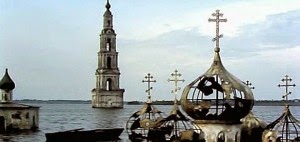Cool! Check out this brand new installment of my on-going series for Amazing Stories - this time on the tragic submergence of Mologa:
The tale of Mologa is singularly odd … as well as tragic … even in the always odd and periodically tragic domain of the lost.
Things, as you are more than aware – especially if you’ve been following this little series – go missing. Paintings, books, films, people … just a little bit of research brings up a remarkable catalog of lost treasures. Some, like the legendary Amber Room, make a twisted kind of sense in their absence: an entire room covered in priceless amber and gold? Surprised it didn’t vanish long before World War 2.
Meanwhile those three novels by Philip K. Dick, King Kong Appears In Edo … and too many others like them … probably just got misplaced somewhere. While things, like Lake Peigneur in Louisiana, may have vanished but then reappeared totally transformed.
Then there’s Mologa. What makes this Russian city odd even among all these oddities is that it still exists: we know exactly where it is … in fact you can even visit it … but that doesn’t mean it’s actually there.
But first, a bit of background: founded sometime in the 12th century in Yaroslavl Oblast, Russia, after a few hundred years – and a history as twisted and convoluted as only a Russian city can have – Mologa, eventually became a key destination on the all-important Asian trade routes.
Even after the – and here’s an understatement – “Time of Troubles” (1598 to 1613) Mologa kept it’s trade importance and, by the 19th century, it had graduated to a valuable link between the Baltic and the Volga River.
Then came Stalin. Uncle Joe had big plans for that region – including the creation of what would become the massive Rybinsk reservoir. How massive? Well, at the time of its creation in 1935 – with it being finally completed filling in 1947 – the Rybinsk reservoir was the largest artificial lake anywhere on Earth. That big.

No comments:
Post a Comment